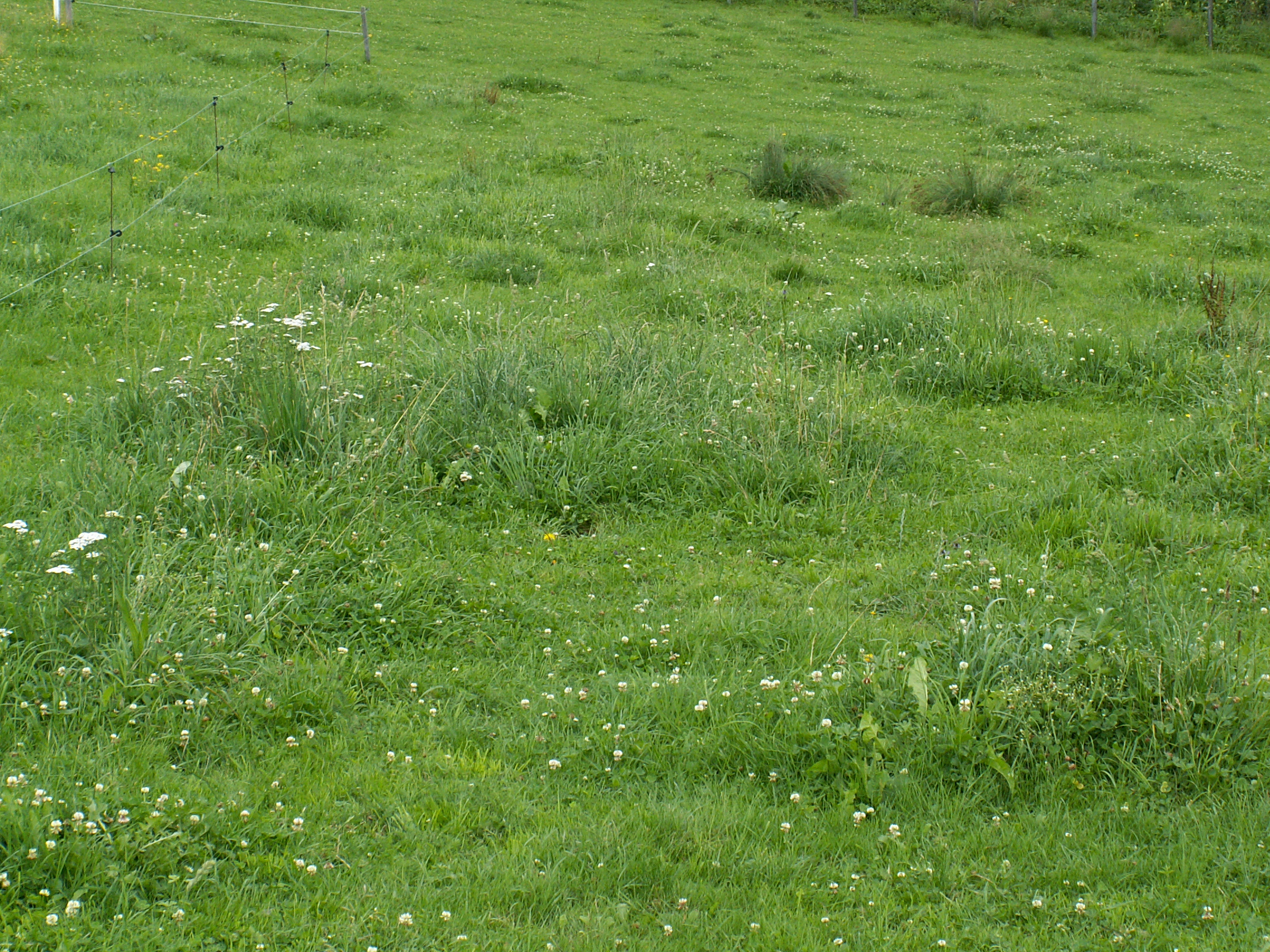The pasture is not divided into a maximum of 4 fields. The area is occupied practically throughout the entire grazing season. If there is a rest period, it never lasts longer than a week. It has to grow back as much as the cows eat every day: “the feed has to grow into the cows’ mouths”. The average growth height is 5-7 cm, the pasture feed is of high and uniform quality. If possible, mowing or mulching should not be necessary. However, if unwanted plants come to seed in the pasture, pasture care is necessary. For short-grass pasture operations, it is advisable to measure the growth height weekly and then adjust the pasture size based on this! pasture available to you for preliminary rough planning of pasture area requirements over the course of the grazing season
Important rules for short grass pasture:
- Be stingy with the area; Aim for a growth height of 5-7 cm. If the population becomes too high (above about 9 cm), the area must be reduced or the number of animals increased. Otherwise the food will become too old and will no longer be eaten with pleasure. In addition, the hot spots are increasing and the cows are grazing too deeply in between. If the hot spots grow too high, they should be mowed down to around 10 cm when the weather is nice. The clippings remain on the area and are usually happily eaten by the cows.
- If the pasture height drops below 5 cm due to overgrazing or drought, animals must either be removed from the area, or more feed must be added or the pasture area must be enlarged.
- With a well-thought-out distribution of the drinking and feeding points, the damage caused by footfalls can be reduced and the excretions are better distributed.
- If hourly grazing is combined with short grass pasture, the animal population is relatively high. In this case, the cattle should come to the pasture hungry so that they mainly eat there and lie down and rest less. This means there is less excretion on the pasture.
To note:
It is important that pasture growth begins on time, especially in spring, and that grazing pressure is generally high.
- When the first company in the region starts towing the meadows, the pasture areas must already be overgrazed!
- If you walk across the short grass pasture at the beginning of the elderberry blossom, you should have the feeling that the cows are not finding enough pasture feed.
If these points apply, then the basis for a good pasture year has been laid according to practical experience.
Short-grass pasture is a very intensive form of grazing and is primarily ideal for intensively used grassland areas. Hilly terrain is particularly problematic with short-grass, all-day pasture - here the lying areas are concentrated in the flat areas, where over-fertilization or poor feed intake occurs. Farms that do not have a large contiguous pasture area can constantly rotate grazing between several pasture areas. This also has the advantage that individual areas can be specifically fertilized during the grazing season and then not grazed for a few days to weeks (depending on the weather). The total pasture area must be able to be increased at least 2-4 times over the course of the year. Manure compost, rotted manure and processed liquid manure are suitable for fertilization. Starting fertilization in spring is important; 1-2 further small amounts of fertilization (e.g. 8-12 m3 of diluted manure/ha) should be carried out in summer if possible. In practice, the short-grass pasture farms alternately fertilize around 25% of the respective pasture areas before rainy periods.
Table: Guideline values for animal numbers per ha for short grass pastures (growing location; stated in animals per ha)
Advantages:
- Low labor and material costs
- High, consistent forage quality throughout the entire growing season
- Low (no) feed losses and, under optimal conditions, no pasture maintenance necessary
- Dense, hard-wearing turf is encouraged
- Short grass pasture can help remediate problem populations (dock docks etc.)
- Calm animal behavior, little damage caused by kicks, low risk of bloating
- Also suitable for damp weather (rainy periods)
- Alternative to portion grazing, which is often not professionally managed, and in some cases to extensive standing grazing
Disadvantages:
- No system for inconsistent terrain (hilly, edge of forest, tubular plots)
- Good soil conditions necessary
- Undergrass pasture plants are absolutely necessary (particularly meadow panicle, in favorable locations also English ryegrass)
- In regions with a risk of drought, paddock farming is usually cheaper (shading the ground, etc.).
- Fertilization during the growing season is more difficult
- Several drinking points for the animals are also required to distribute the excretions
- When starting a new breed, feed growth must be measured weekly
- Grazing takes more time for dairy cows (large area for cows)






